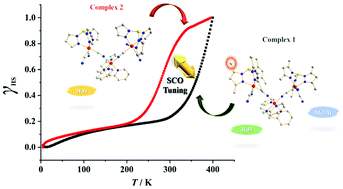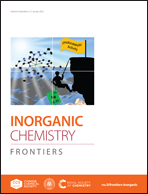Tuning of spin-crossover behavior in two cyano-bridged mixed-valence Fe III2FeII trinuclear complexes based on a TpR ligand†
Abstract
Spin-crossover (SCO) complexes have been extensively studied in the past few decades owing to their bistable nature which find application in a myriad of areas. In order to enhance and optimize the SCO behavior, considerable attention is being paid towards the synthesis of discrete multinuclear spin-crossover complex systems. Here, two mixed-valence FeIII2FeII trinuclear complexes of the formula {[FeII(TPMA)][FeIII(TpR)(CN)3]2}·MeOH·2H2O (1) and {[FeII(TPMA)][FeIII(TpR)(CN)3]2}·H2O (2) [where TPMA = tris(2-pyridylmethyl)amine, Tp = tris(pyrazol-1-yl)borate, R = 3,5-dimethyl for 1 and H for 2] were synthesized and characterized. Magnetic measurements confirmed that complex 1 undergoes SCO at a high temperature (T1/2 = 410 K for the fresh sample and T1/2 = 406 K for the dried sample), while complex 2 displays near room temperature SCO (T1/2 = 283 K for the fresh sample and T1/2(↑) = 283 K and T1/2(↓) = 257 K for the dried sample). To the best of our knowledge, complex 1 has the highest transition temperature reported among trinuclear SCO complexes so far, which is a remarkable feature of multinuclear materials. Slight structural modifications tend to upend the SCO behavior which paves the way for fine tuning SCO.



 Please wait while we load your content...
Please wait while we load your content...